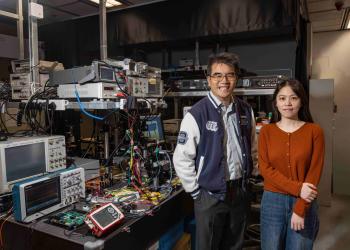HKUST-led Research Team Unveils Groundbreaking Quantum Simulation of 3D Topological Matter with Ultracold Atoms
Complex topological matter (peculiar materials with different bulk and surface properties) has become the focus of both industrial and academic research because it is seen as a way to eventually make quantum computing more noise-free and robust. Today’s physical quantum computers are still noisy, and the protection of fragile quantum information against noises is a growing field of research. The goal of fault-tolerant quantum computing is to maintain its functionality in the presence of noise, which has driven investment into complex topological matter.
Prof. JO Gyu-Boong, Associate Professor from the Department of Physics at the Hong Kong University of Science and Technology (HKUST) and Prof. LIU Xiongjun, Professor from the School of Physics at Peking University (PKU), have successfully created the world’s first 3D simulation of topological matter consisting of ultracold atoms, prepared at 30 billionths of a degree above absolute zero, paving the way for further examination of new topological matter that cannot be well realized in solids. Such never-before-done engineering artificial material with ultracold atoms may allow physicists to model unusual phases of matter that may lead to the development of new quantum devices.
The topological nature of the material means that it tends to withstand imperfections within an operating system and also holds the potential for other yet unknown exotic properties.
Previous attempts at topological matter simulations were limited to lower dimensions, due to challenges on how to characterize 3D band topology in atomic systems. The simulation in 3D would enable full investigation of nontrivial topological phases that are not available in 1D or 2D, including various insulating, semimetal, and superfluid phases in ultracold atoms.
The physicists devised an artificial crystal lattice structure in which ultracold atoms move around likewise electrons in solids. In experiments, the researchers coupled the atomic spin with the direction of atomic motion making such synthetic matter topological, and observed peculiar energy spectrum using an innovative detection technique. This new synthetic quantum matter is a 3D spin-orbit coupled nodal-line topological semimetal.
The research was recently published online in Nature Physics on July 29, 2019 (DOI:10.1038/s41567-019-0564-y).
“Our work opens up many possibilities for developing new topological materials that do not occur naturally,” said Prof. Jo. “This development demonstrates there is a new possibility to explore complex topological material in 3D, and will provide a useful platform for quantum simulation.”
This work is further research of the previous work published by the collaborating team in Science Advances 4, eaao4748 (2018).











